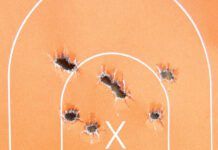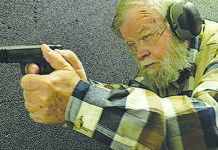It is hard to say who was the first gunsmith to drill or cut holes near the muzzle of a shotgun barrel to direct the expanding gas upward to provide a downward push, thus limiting both muzzle jump and felt recoil. Credit for this concept is generally given to Marine Corps Colonel Richard M. Cutts. His “compensator” was originally intended to be used on military weapons to minimize recoil and to reduce muzzle climb in fully automatic weapons. It was eventually adopted for use on the Thompson submachine gun, and a “Cutts Compensator” was soon made available to the civilian shotgun market by the Lyman Company.
The first examples of gas redirection being used without an add-on compensator or choke chamber were generally found on cheap single-barreled shotguns, and they usually consisted of slits cut across the top of the shotgun’s barrel just behind the choke. This proved to be a very effective system of limiting muzzle jump without the expense of an add-on appliance, but the effort was generally wasted on bolt-action and break-open single-shot guns, in which the benefit of faster second target acquisition as a result of less muzzle jump was meaningless.
In recent years, target shooters and hunters have made barrel porting extremely popular, due to the increased popularity of clay target sports and to the research and marketing of some major gun repair shops including Stan Baker, Mag-na-port/Pro-port, Laser Port, and, most recently, the addition of this porting feature by many shotgun manufacturers.
How It’s Done
Shotgun barrel porting can be done in almost any repair shop with a minimal investment in power equipment. In my shop we do barrel porting on a bench mill, but a sturdy drill press (with a tight spindle) equipped with a cross-slide table and an angle vise could also be used. Another method uses the lathe as a drill. This allows the gunsmith to use the accuracy of the lathe’s cross slide to index drilled holes properly, while the shotgun barrel is attached to a milling vise, which in turn is attached to the lathe’s tool post. Let’s start with barrel porting on the mill/drill machine.
In using the milling machine to both cut and index barrel ports, the first decision to be made is how to locate the first hole so that it can be found again to serve as a reference for subsequent rows of holes. I use the barrel’s front bead as an initial reference by laying the barrel on its side through the milling vise and pulling it back until the front bead rests against the outside of the vise jaw. Before tightening, make sure that the barrel is level and that the rib is perfectly parallel to the vise jaws. This method of locating the barrel in the milling vise works extremely well, but to ensure that you can rotate the vise 180 degrees to index the first hole on the second side of the barrel using the vise jaw edge and front bead, you must first be sure that the jaws on your milling vise measure exactly the same from edge to center. Since this is usually not the case, you will first have to make a truing cut across both outer edges of your milling vise. This should done with a carbide end mill. Make a light cut across the outer edge of your vise jaws. This cut should be no more than 3/8 inch down from the top of the jaws and only deep enough to true the edge. Rotate your vise 180 degrees (without adjusting the cross slide) and make an identical cut on the opposite side. The two outer edges of your milling vise are now the same distance from the center.
Once the barrel is leveled and tightened in the milling vise, choose the location for the first port hole. Be certain to start this row of holes well behind the choke. If the barrel has a built-in or fixed choke, I like to be sure to start the holes far enough back so that the owner can install any choke system he or she chooses in the future. Set the angle of your vise to 15 degrees and install either a #3 center drill, a #31 carbide drill or an 1/8-inch end mill (I have tried all three of these sizes and they all work well, but I prefer using the #31 carbide drill). With your cross-slide hand wheel set at 0, drill the first hole into the shotgun barrel. Now turn the handwheel clockwise three complete revolutions (or 0.300 inch) and drill the next port. Repeat this operation until you have drilled the desired number of port holes in this lower row. I drill seven holes in each row, but this is a personal preference. Back up the cross-slide hand wheel to its original location. Be certain that the drill can be lowered easily into the first hole in the row. If you are porting an over/under barrel set, this is the time to drill the first row of holes in the second barrel and once again back up the cross-slide hand wheel to its original location. Be certain that it can be lowered easily into the first hole in the row. Raise the spindle and turn the cross-slide hand wheel clockwise 11/2 turns (0.150 inch). You have just offset the upper row of barrel ports by half of the distance from hole to hole. Set the angle of the milling vise to 30 degrees. Drill the upper row of barrel ports at the same three-revolution (0.300 inch) spacing.
Now it is time to index the first hole in the opposite side of the shotgun barrel. Once again set the vise angle to 15 degrees and back up the cross-slide hand wheel to its original location (the very first hole that was drilled). Be certain that the drill can be lowered easily into the hole. Remove the shotgun barrel from the milling vise and rotate the vise 180 degrees. Reinstall the shotgun barrel in the milling vise (exposing the opposite side to the drill), again using the front bead against the edge of the vise jaw to ensure proper indexing of the drilled holes. You can see now why it is important to true the edges of the vise jaws. Drill the barrel ports in this side of the shotgun barrel, duplicating the steps used on the first side.
Remove the shotgun barrel from the vise and observe the barrel ports from above the barrel. You will see four rows of drilled holes, neatly cut and accurately indexed. Touch up the bare metal with a cold bluing solution (I like Brownells’ Oxpho-Blue or Birchwood Casey’s Super-Blue).
You must now deburr the inside of the barrel. This can be done in a number of ways, but do not use a “ball type” cylinder hone. The rough burrs left by the drill on the inside of the shotgun barrel will not only ruin the hone, but the ball design of the hone will deform the drilled holes as it is turned within the bore.
The simplest method of polishing this area is to use a piece of 5/8-inch hardwood dowel, slit with a hacksaw about 3 inches to accept a piece of medium emery cloth wrapped clockwise around the dowel. Install this “tool” in the headstock of the lathe and insert it into the barrel from the chamber. Run it at a relatively high speed while pushing the shotgun barrel over the emery cloth until the cloth can be seen through the newly drilled barrel ports. Just a few seconds of polishing with this method will remove all burrs. In my shop we deburr ported shotgun barrels using a Sunnen bushing grinder with the correct mandrel inserted in the muzzle. Starting with a medium stone, quickly remove the burrs from the bore. Repeat this operation with a fine hone stone. Polishing this area will take no more than a minute.
Lathe Drilling
If you do not have a bench mill, barrel ports can be drilled on the lathe. For this you will need a drill chuck and tapered adapter to install in the lathe spindle, a milling vise attached to the lathe tool post, and an adjustable sight level (available from Brownells). Though this method does not offer the visibility the milling machine does, holes can be very accurately indexed and spaced by using the lathe’s cross-slide hand wheel.
The easiest way I have found to properly index port holes when drilling them on the lathe is to drill the lower row at 90 degrees to the bore (rather than turning this row of holes upward 15 degrees as was done on the bench mill). Once the location of the first port hole has been decided (slightly above center and well behind the choke), place the barrel in the milling vise on the tool post with its muzzle pointing away and its rib leveled in both directions. Move the shotgun barrel into the rotating #31 carbide drill by using the hand wheel.
With great care, continue drilling until your drill has exited the opposite side of the shotgun barrel. You will only drill through both sides of the barrel once. This single hole will be used to properly index the port holes on the opposite side. Now drill a row of holes, turning the cross-slide hand wheel three revolutions (0.300 inch) between holes. Back up the cross-slide hand wheel to its original location. Be certain that the drill can be inserted easily into the first hole in the row. Set the adjustable sight level to 30 degrees and attach it to the barrel’s rib with a rubber band. Loosen the milling vise and very carefully turn the barrel 30 degrees as indicated on the sight level. I find it helpful to place a piece of medium emery cloth (grit up) above the barrel to keep it from slipping in the milling vise while it is clamped at this angle. Offset the top row of port holes 0.150 inch with the cross-slide hand wheel and drill the second row of barrel ports. With this completed, turn the barrel around in the milling vise and set the drill in the barrel port that was drilled all the way through the shotgun barrel. Use this point to index the barrel ports on this side of the shotgun barrel. Then, deburr the bore. ★




















